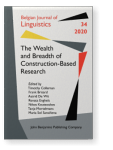Patterns of coining and constructions
The role of productivity
We develop the notion of
pattern of coining found in some complete-inheritance models of Construction Grammar (
Fillmore 1997;
Kay 2013), which are processes used to coin new units based on analogy with an existing one. Unlike constructions, they cannot be considered systematically productive in synchrony. After providing measurement methods, we assess the productivity of three patterns (‧
whelm, ‧
licious and ‧
holic). To do so, we carried out a statistical analysis using two web corpora. Unlike Kay, we show that the difference between constructions and patterns of coining is not so clear-cut, since patterns of coining may undergo constructionalization, and that qualitative aspects should be taken into account along with quantitative data when trying to assess the status of a word-formation pattern.
Article outline
- 1.Introduction
- 2.Defining productivity
- 3.Kay’s patterns of coining
- 4.Productivity of other potential patterns of coining
- 5.Discussion
- 6.Conclusion
- Acknowledgements
- Notes
-
References
References (20)
References
Baayen, Harald. 2009. “Corpus Linguistics in Morphology: Morphological Productivity.” In Corpus Linguistics: An International Handbook, ed. by Anke Lüdeling, and Merja Kytö, 900–919. Berlin/New York: Mouton de Gruyter.
Bybee, Joan. 2001. Phonology and Language Use. Cambridge: Cambridge University Press. 

Bybee, Joan. 2006. “From Usage to Grammar: The Mind’s Response to Repetition.” Language 82 (4): 711–733. 

Cappelle, Bert. 2014. “Conventional Combinations in Pockets of Productivity: English Resultatives and Dutch Ditransitives Expressing Excess.” In Extending the Scope of Construction Grammar, ed. by Ronny Boogaart, Timothy Colleman, and Gijsbert Rutten, 251–281. Berlin/New York: Mouton de Gruyter. 

Dal, Georgette, and Fiammetta Namer. 2017. “Playful Nonce-Formations, Creativity and Productivity.” In Expanding the Lexicon. Linguistic Innovation, Morphological Productivity, and Ludicity, ed. by Sabine Arndt-Lappe, Angelika Braun, Claudine Moulin, and Esme Winter-Froemel, 203–228. Berlin/New York: Mouton de Gruyter.
Desagulier, Guillaume. 2016. “A Lesson from Associative Learning: Asymmetry and Productivity in Multiple-Slot Constructions.” Corpus Linguistics and Linguistic Theory, 12 (2): 173–219. 

Fillmore, Charles J. 1997. Construction Grammar Lecture Notes. ([URL])
Fillmore, Charles J., Paul Kay, and Mary C. O’Connor. 1988. “Regularity and Idiomaticity in Regular Constructions: The Case of Let Alone
.” Language 64 (3): 501–538. 

Goldberg, Adele. 2019. Explain Me This. Creativity, Competition, and the Partial Productivity of Constructions. Princeton: Princeton University Press.
Hamans, Camiel. 2020. “Contra de linguïstische preutsheid: Over -gate en andere libfixen [Against linguistic prudishness: On -gate and other libfixes].” Nederlandse Taalkunde 25 (2/3): 319–332. 

Kay, Paul. 2002. Patterns of coining. Typoscript available at <[URL]>
Kay, Paul. 2013. “The Limits of (Construction) Grammar.” In The Oxford Handbook of Construction Grammar, ed. by Thomas Hoffmann, and Graeme Trousdale, 32–48. Oxford: Oxford University Press.
Lakoff, George, and Mark Johnson. 1980. Metaphors We Live By. Chicago: University of Chicago Press.
Norde, Muriel, and Sarah Sippach. 2019. “Nerdalicious Scientainment: A Network Analysis of English Libfixes.” Word Structure 12 (3): 353–384. 

Perek, Florent. 2018. “Recent Change in the Productivity and Schematicity of the Way-Construction: A Distributional Semantic Analysis”. Corpus Linguistics and Linguistic Theory 14 (1): 65–97. 

Pfänder, Stefan, and Heike Behrens. 2016. Experience Counts: Frequency Effects in Language. Berlin/New York: Mouton de Gruyter.
Plag, Ingo. 1999. Morphological productivity: Structural Constraints in English Derivation. Berlin/New York: Mouton de Gruyter.
Pullum, Geoffrey, and Rodney Huddleston. 2002. “Prepositions and preposition phrases.” In The Cambridge Grammar of the English Language, ed. by Rodney Huddleston, and Geoffrey Pullum, 597–661. Cambridge: Cambridge University Press. 

Schultink, Hendrik. 1961. “Produktiviteit als morfologisch fenomeen [Productivity as a morphological phenomenon].” Forum der Letteren 21: 110–125.
Tyler, Andrea, and Vyvyan Evans. 2003. The Semantics of English Prepositions: Spatial Scenes, Embodied Meaning and Cognition. Cambridge: Cambridge University Press. 

